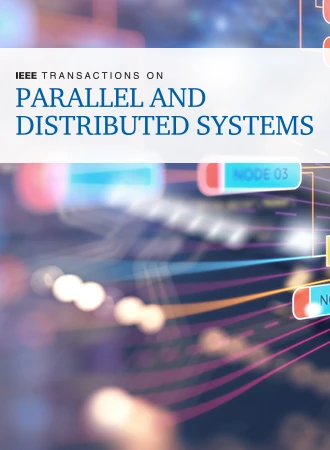在异构系统上高效利用多线程并行性实现稀疏张量收缩
IF 5.6
2区 计算机科学
Q1 COMPUTER SCIENCE, THEORY & METHODS
IEEE Transactions on Parallel and Distributed Systems
Pub Date : 2024-04-19
DOI:10.1109/TPDS.2024.3391254
引用次数: 0
摘要
许多科学模拟领域,如化学和凝聚态物理,越来越多地放弃密集张量收缩,转而使用稀疏张量收缩。在这项工作中,我们围绕二进制稀疏张量收缩(SpTC)展开研究,它面临着索引匹配和累积的挑战。为了解决这些难题,我们提出了在 CPU-GPU 异构系统上高效的按元素划分的 SpTC 框架--GSpTC。GSpTC 首先引入了基于元素张量收缩的细粒度分区策略。通过分析和选择适当的维度划分策略,我们可以有效利用 GPU 上的多线程并行性,优化 GSpTC 的整体性能。特别是,GSpTC 在收缩阶段和合并阶段利用了 GPU 上的多线程并行性,大大加快了稀疏张量收缩计算中的计算阶段。此外,GSpTC 还采用了并行流水线技术,隐藏了主机和设备之间的数据传输时间,进一步提高了性能。因此,与之前最先进的框架 Sparta 相比,GSpTC 的平均性能提高了 267%。本文章由计算机程序翻译,如有差异,请以英文原文为准。
Efficient Utilization of Multi-Threading Parallelism on Heterogeneous Systems for Sparse Tensor Contraction
Many fields of scientific simulation, such as chemistry and condensed matter physics, are increasingly eschewing dense tensor contraction in favor of sparse tensor contraction. In this work, we center around binary sparse tensor contraction (SpTC) which has the challenges of index matching and accumulation. To address these difficulties, we present GSpTC, an efficient element-wise SpTC framework on CPU-GPU heterogeneous systems. GSpTC first introduces a fine-grained partitioning strategy based on element-wise tensor contraction. By analyzing and selecting appropriate dimension partitioning strategies, we can efficiently utilize the multi-threading parallelism on GPUs and optimize the overall performance of GSpTC. In particular, GSpTC leverages multi-threading parallelism on GPUs for the contraction phase and merging phase, which greatly accelerates the computation phase in sparse tensor contraction computations. Furthermore, GSpTC employs parallel pipeline technology to hide the data transmission time between the host and the device, further enhancing its performance. As a result, GSpTC achieves an average performance improvement of 267% compared to the previous state-of-the-art framework Sparta.
求助全文
通过发布文献求助,成功后即可免费获取论文全文。
去求助
来源期刊

IEEE Transactions on Parallel and Distributed Systems
工程技术-工程:电子与电气
CiteScore
11.00
自引率
9.40%
发文量
281
审稿时长
5.6 months
期刊介绍:
IEEE Transactions on Parallel and Distributed Systems (TPDS) is published monthly. It publishes a range of papers, comments on previously published papers, and survey articles that deal with the parallel and distributed systems research areas of current importance to our readers. Particular areas of interest include, but are not limited to:
a) Parallel and distributed algorithms, focusing on topics such as: models of computation; numerical, combinatorial, and data-intensive parallel algorithms, scalability of algorithms and data structures for parallel and distributed systems, communication and synchronization protocols, network algorithms, scheduling, and load balancing.
b) Applications of parallel and distributed computing, including computational and data-enabled science and engineering, big data applications, parallel crowd sourcing, large-scale social network analysis, management of big data, cloud and grid computing, scientific and biomedical applications, mobile computing, and cyber-physical systems.
c) Parallel and distributed architectures, including architectures for instruction-level and thread-level parallelism; design, analysis, implementation, fault resilience and performance measurements of multiple-processor systems; multicore processors, heterogeneous many-core systems; petascale and exascale systems designs; novel big data architectures; special purpose architectures, including graphics processors, signal processors, network processors, media accelerators, and other special purpose processors and accelerators; impact of technology on architecture; network and interconnect architectures; parallel I/O and storage systems; architecture of the memory hierarchy; power-efficient and green computing architectures; dependable architectures; and performance modeling and evaluation.
d) Parallel and distributed software, including parallel and multicore programming languages and compilers, runtime systems, operating systems, Internet computing and web services, resource management including green computing, middleware for grids, clouds, and data centers, libraries, performance modeling and evaluation, parallel programming paradigms, and programming environments and tools.
 求助内容:
求助内容: 应助结果提醒方式:
应助结果提醒方式:


